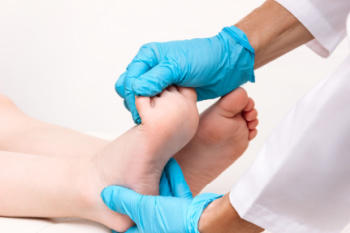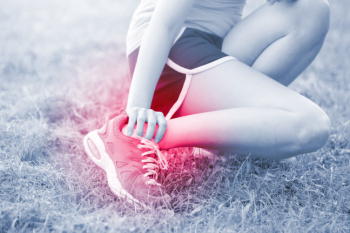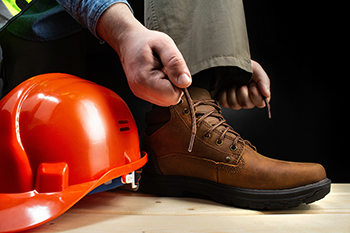
May 2024
Lower Limb and Foot Injuries in Athletic Children
 Lower limb and foot injuries are common in athletic children, partly due to the vulnerability of their growth plates. Growth plates are the developing areas of cartilage at the end of the long bones in the legs where bone growth takes place. These plates are weaker than nearby tendons and ligaments, making them more susceptible to injury. This is especially true when under the stress of repetitive physical activities in sports. Movements like running, jumping, and quick pivoting can place excessive strain on growth plates, leading to conditions such as Sever's disease, or heel pain. Ankle sprains are also common because ligaments in children tend to be more elastic than in adults. The biomechanics of growing children, such as variations in gait, muscle strength, and coordination during growth spurts, can further predispose them to these injuries as their bodies adapt to rapid physical changes. A podiatrist, or foot doctor, can treat these types of injuries common in active children. They may suggest treatments ranging from rest and elevation to custom orthotics that support proper alignment and reduce stress on the growth plates. Treatments vary depending on the injury. If your child is struggling with a lower limb or foot injury, it is suggested you consult with a podiatrist for targeted care.
Lower limb and foot injuries are common in athletic children, partly due to the vulnerability of their growth plates. Growth plates are the developing areas of cartilage at the end of the long bones in the legs where bone growth takes place. These plates are weaker than nearby tendons and ligaments, making them more susceptible to injury. This is especially true when under the stress of repetitive physical activities in sports. Movements like running, jumping, and quick pivoting can place excessive strain on growth plates, leading to conditions such as Sever's disease, or heel pain. Ankle sprains are also common because ligaments in children tend to be more elastic than in adults. The biomechanics of growing children, such as variations in gait, muscle strength, and coordination during growth spurts, can further predispose them to these injuries as their bodies adapt to rapid physical changes. A podiatrist, or foot doctor, can treat these types of injuries common in active children. They may suggest treatments ranging from rest and elevation to custom orthotics that support proper alignment and reduce stress on the growth plates. Treatments vary depending on the injury. If your child is struggling with a lower limb or foot injury, it is suggested you consult with a podiatrist for targeted care.
The health of a child’s feet is vital to their overall well-being. If you have any questions regarding foot health, contact Dr. Randy Garr of Bigfoot Podiatry. Our doctor can provide the care you need to keep you pain-free and on your feet.
Tips for Keeping Children's Feet Healthy
- Make sure their shoes fit properly
- Look for any signs of in-toeing or out-toeing
- Check to see if they have Clubfoot (condition that affects your child’s foot and ankle, twisting the heel and toes inward) which is one of the most common nonmajor birth defects.
- Lightly cover your baby’s feet (Tight covers may keep your baby from moving their feet freely, and could prevent normal development)
- Allow your toddler to go shoeless (Shoes can be restricting for a young child’s foot)
- Cut toenails straight across to avoid ingrown toenails
- Keep your child’s foot clean and dry
- Cover cuts and scrapes. Wash any scratches with soap and water and cover them with a bandage until they’ve healed.
If you have any questions, please feel free to contact our office located in Provo, UT . We offer the newest diagnostic and treatment technologies for all your foot care needs.
Common Achilles Tendon Injuries
 The Achilles tendon connects the calf muscles to the heel bone. This tendon is susceptible to different kinds of injuries that can affect mobility and cause pain. Common injuries include Achilles tendonitis, Achilles bursitis, and Achilles tendon rupture. Achilles tendonitis is where repetitive stress and overuse lead to inflammation of the tendon, which causes pain and swelling near the heel. Achilles bursitis involves inflammation of the bursa, a small fluid-filled sac located near the heel bone. This condition causes similar symptoms to tendonitis but occurs at the back of the heel. An Achilles tendon rupture is more severe and involves a partial or complete tear of the tendon, often accompanied by sudden, sharp pain and an inability to walk properly. Treatment varies depending on the severity of the injury but may include rest, targeted stretching exercises, and in severe cases of rupture, surgical intervention. Regular visits to a podiatrist are important for proper diagnosis, management of symptoms, and guidance on rehabilitation to ensure effective recovery. If you have an injured Achilles tendon, it is suggested that you make an appointment with a podiatrist today.
The Achilles tendon connects the calf muscles to the heel bone. This tendon is susceptible to different kinds of injuries that can affect mobility and cause pain. Common injuries include Achilles tendonitis, Achilles bursitis, and Achilles tendon rupture. Achilles tendonitis is where repetitive stress and overuse lead to inflammation of the tendon, which causes pain and swelling near the heel. Achilles bursitis involves inflammation of the bursa, a small fluid-filled sac located near the heel bone. This condition causes similar symptoms to tendonitis but occurs at the back of the heel. An Achilles tendon rupture is more severe and involves a partial or complete tear of the tendon, often accompanied by sudden, sharp pain and an inability to walk properly. Treatment varies depending on the severity of the injury but may include rest, targeted stretching exercises, and in severe cases of rupture, surgical intervention. Regular visits to a podiatrist are important for proper diagnosis, management of symptoms, and guidance on rehabilitation to ensure effective recovery. If you have an injured Achilles tendon, it is suggested that you make an appointment with a podiatrist today.
Achilles tendon injuries need immediate attention to avoid future complications. If you have any concerns, contact Dr. Randy Garr of Bigfoot Podiatry. Our doctor can provide the care you need to keep you pain-free and on your feet.
What Is the Achilles Tendon?
The Achilles tendon is a tendon that connects the lower leg muscles and calf to the heel of the foot. It is the strongest tendon in the human body and is essential for making movement possible. Because this tendon is such an integral part of the body, any injuries to it can create immense difficulties and should immediately be presented to a doctor.
What Are the Symptoms of an Achilles Tendon Injury?
There are various types of injuries that can affect the Achilles tendon. The two most common injuries are Achilles tendinitis and ruptures of the tendon.
Achilles Tendinitis Symptoms
- Inflammation
- Dull to severe pain
- Increased blood flow to the tendon
- Thickening of the tendon
Rupture Symptoms
- Extreme pain and swelling in the foot
- Total immobility
Treatment and Prevention
Achilles tendon injuries are diagnosed by a thorough physical evaluation, which can include an MRI. Treatment involves rest, physical therapy, and in some cases, surgery. However, various preventative measures can be taken to avoid these injuries, such as:
- Thorough stretching of the tendon before and after exercise
- Strengthening exercises like calf raises, squats, leg curls, leg extensions, leg raises, lunges, and leg presses
If you have any questions please feel free to contact our office located in Provo, UT . We offer the newest diagnostic tools and technology to treat your foot and ankle needs.
Factors in Choosing Proper Work Boots

Having the right pair of work boots is important for specific types of jobs. Beyond comfort, they ensure safety, durability, and even style. Before exploring boot options, it is helpful to assess your work environment to select boots with suitable safety features. Composite toe work boots are lightweight yet durable, ideal for hazardous environments. Soft toe work boots offer comfort and protection against slips in less hostile settings. Waterproof boots with breathable liners keep feet dry, while insulated boots provide warmth and cushioning in cold climates. Prioritizing safety features, comfort, and functionality helps you find the right pair of boots to support you through long work days. It is also essential to consider foot health too, and consulting a podiatrist for personalized recommendations can be beneficial. Purchasing quality work boots is investing in your safety and comfort on the job. By balancing safety, comfort and functionality, you can find work boots that meet all your needs. If your type of job requires protecting the feet from injury or puts you at risk of other foot ailments, it is suggested that you schedule an appointment with a podiatrist for help in selecting appropriate footwear.
While working on the feet, it is important to take the proper care of them. For more information about working on your feet, contact Dr. Randy Garr from Bigfoot Podiatry. Our doctor will treat your foot and ankle needs.
Working on Your Feet
Standing on your feet for long periods of time can cause stress and pain in your feet. Your whole body may experience change in terms of posture, back pain, bunions, callouses and or plantar warts. There are ways to avoid these conditions with proper foot care, smart choices and correct posture.
Positive Changes
Negative heeled shoe – Choosing this shoe type places the heel slightly lower than the ball of the foot. These are great for overall foot health. Find shoes that fit you correctly.
Go barefoot – Our feet were not designed to be enclosed for all hours of the day. Try to periodically expose your feet to air.
Eliminate Pain
Foot Exercises – Performing simple exercises, incorporating yoga and doing stretches are beneficial. This will allow increased blood flow to the area and muscles of the foot.
Achilles tendon – Stretching the foot out flat on the floor will relax the calf muscles and tendon. These exercises can be performed almost anywhere. Make sure you add these exercises to your daily regimen.
With a little bit of this information and knowing more about foot health, you will notice changes. Foot stretches and proper footwear will help with pain and prevent further issues.
If you have any questions please feel free to contact our office located in Provo, UT . We offer the newest diagnostic and treatment technologies for all your foot and ankle needs.
Treatment for Foot Corns
 Corns are thickened skin areas that form to protect the skin against friction and pressure, and often occur on the feet. A podiatrist, or foot doctor, may recommend changing to footwear that fits better and doesn't squeeze or rub against the foot. Additionally, they might recommend padding or cushions to protect the corn and reduce pressure when walking. In more persistent cases, a podiatrist may carefully trim the thickened skin using a scalpel, a procedure that should never be attempted at home because of the risk of infection. Custom foot orthotics may also be suggested to correct any foot abnormalities that contribute to corn formation. Along with proper foot hygiene, these treatments can effectively manage and prevent the discomfort associated with corns. If you are struggling with corns on the feet, it is suggested that you consult a podiatrist for help.
Corns are thickened skin areas that form to protect the skin against friction and pressure, and often occur on the feet. A podiatrist, or foot doctor, may recommend changing to footwear that fits better and doesn't squeeze or rub against the foot. Additionally, they might recommend padding or cushions to protect the corn and reduce pressure when walking. In more persistent cases, a podiatrist may carefully trim the thickened skin using a scalpel, a procedure that should never be attempted at home because of the risk of infection. Custom foot orthotics may also be suggested to correct any foot abnormalities that contribute to corn formation. Along with proper foot hygiene, these treatments can effectively manage and prevent the discomfort associated with corns. If you are struggling with corns on the feet, it is suggested that you consult a podiatrist for help.
If you have any concerns regarding your feet and ankles, contact Dr. Randy Garr of Bigfoot Podiatry. Our doctor will treat your foot and ankle needs.
Corns: What Are They? and How Do You Get Rid of Them?
Corns can be described as areas of the skin that have thickened to the point of becoming painful or irritating. They are often layers and layers of the skin that have become dry and rough, and are normally smaller than calluses.
Ways to Prevent Corns
There are many ways to get rid of painful corns such as wearing:
- Well-fitting socks
- Comfortable shoes that are not tight around your foot
- Shoes that offer support
Treating Corns
Treatment of corns involves removing the dead skin that has built up in the specific area of the foot. Consult with Our doctor to determine the best treatment option for your case of corns.
If you have any questions please feel free to contact our office located in Provo, UT . We offer the newest diagnostic and treatment technologies for all your foot and ankle needs.






